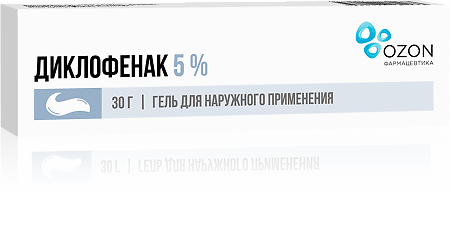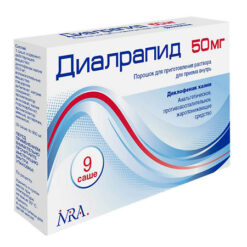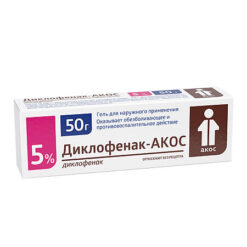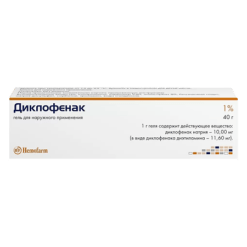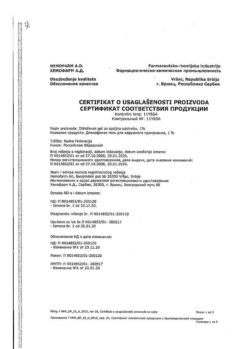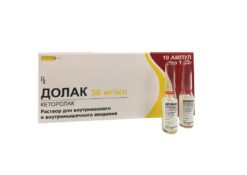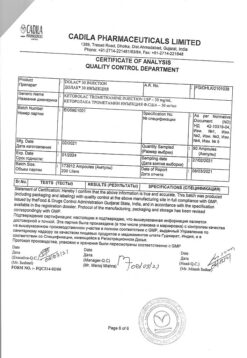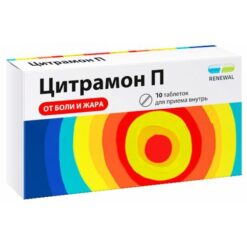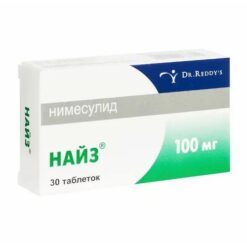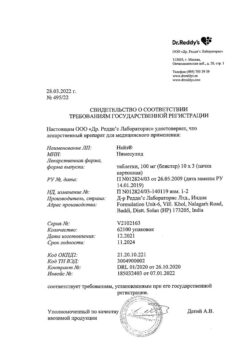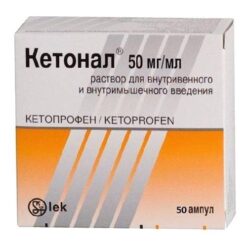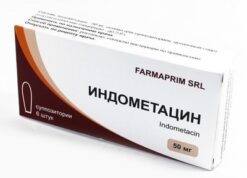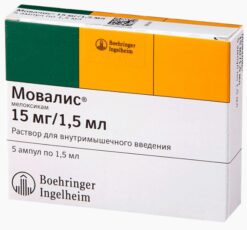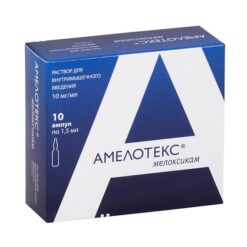No products in the cart.
Diclofenac, gel 5% 30 g
€7.77 €6.00
Description
Pharmacotherapeutic group
Non-steroidal anti-inflammatory drug (NSAID)
ATX Code
S01BC03
Pharmacodynamics: The active ingredient is diclofenac, a nonsteroidal anti-inflammatory drug with pronounced analgesic and anti-inflammatory properties.
In external application diclofenac penetrates well through the skin and is mainly concentrated in the center of inflammation and synovial fluid. The quantity of diclofenac which is absorbed through skin is proportional to the time of gel contact with skin and to the application surface area depends on the total dose of the preparation and on the degree of skin hydration. With the recommended method of application of the drug no more than 6% of diclofenac is absorbed. Application of the occlusive dressing for 10 hours leads to a 3-fold increase in resorption of diclofenac.
Indications
Indications
– inflammatory diseases of the musculoskeletal system (rheumatoid arthritis, psoriatic arthritis, juvenile chronic arthritis, ankylosing spondylitis, gouty arthritis);
– rheumatic lesions of soft tissues (tenosynovitis, bursitis, damage to periarticular tissues);
– degenerative diseases of the musculoskeletal system (deforming osteoarthritis, osteochondrosis);
– post-traumatic inflammation of tendons, ligaments, muscles and joints (as a result of damage during stress and bruises);
– pain and swelling associated with diseases of muscles and joints (lumbago, sciatica, neuralgia, myalgia, tendinitis).
Intended for symptomatic therapy to reduce pain and inflammation at the time of use and does not affect the progression of the disease.
Pharmacological effect
Pharmacological effect
Pharmacotherapeutic group
Nonsteroidal anti-inflammatory drug (NSAID)
ATX code
S01BC03
Pharmacodynamics:
The active component is diclofenac, a non-steroidal anti-inflammatory drug with pronounced analgesic and anti-inflammatory properties.
Indiscriminately inhibiting cyclooxygenase types 1 and 2 disrupts the metabolism of arachidonic acid and the synthesis of prostaglandins, which are the main link in the development of inflammation. In rheumatic diseases, it reduces swelling, hyperemia and pain at rest and during movement, morning stiffness and swelling of the joints, improving their functional ability. In case of postoperative and traumatic injuries, it quickly suppresses pain and inflammation in the area of application of the drug and promotes the resorption of post-traumatic hematoma.
Pharmacokinetics:
When applied externally, diclofenac penetrates well through the skin, mainly concentrating in the site of inflammation and synovial fluid. The amount of diclofenac that is absorbed through the skin is proportional to the time of contact of the gel with the skin and the area of its application depends on the total dose of the drug and the degree of hydration of the skin. With the recommended method of applying the drug, no more than 6% of diclofenac is absorbed. The use of an occlusive dressing for 10 hours leads to a 3-fold increase in the resorption of diclofenac.
Special instructions
Special instructions
Apply externally only. The gel can only be applied to intact areas of the skin. After applying the gel, you should not apply an occlusive dressing. Before use in patients with gastric and duodenal ulcers, impaired liver function, renal function or hematopoietic system, as well as the simultaneous use of other non-steroidal anti-inflammatory drugs, you should consult a doctor.
When using the drug together with other dosage forms of diclofenac, the maximum daily dose should be taken into account. With prolonged use and/or application to large surfaces, systemic side effects may develop due to the resorptive effect. Avoid contact of the drug with the eyes, mucous membranes or open wounds.
Impact on the ability to drive vehicles. Wed and fur.:
The drug does not affect the ability to drive a car or use other mechanical means.
Active ingredient
Active ingredient
Diclofenac
Composition
Composition
100 g of gel contains:
Active substance:
Diclofsnak sodium (calculated on 100% dry matter) – 1.00 g
Excipients:
isopropanol – 45.00 g,
macrogol 7 glyceryl cocoate – 6.00 g,
hypromellose-4 thousand (in terms of dry matter) – 3.00 g,
Scots pine needle oil – 0.15 g,
lavender oil – 0.05 g,
purified water – up to 100.00 g.
Pregnancy
Pregnancy
The drug should not be used in the third trimester of pregnancy. There is no experience with the use of the drug during breastfeeding. Use in the first and second trimesters is possible only after consultation with a doctor if the expected benefit to the mother outweighs the potential risk to the fetus.
Contraindications
Contraindications
Hypersensitivity to diclofenac.
Complete or incomplete combination of bronchial asthma, recurrent polyposis of the nose and paranasal sinuses and intolerance to acetylsalicylic acid or other non-steroidal anti-inflammatory drugs (including a history).
Pregnancy (III trimester) period of breastfeeding, childhood (up to 12 years). Violation of the integrity of the skin at the intended site of application.
With caution:
Hepatic porphyria (exacerbation) erosive and ulcerative lesions of the gastrointestinal tract, severe dysfunction of the liver and kidneys, chronic heart failure, blood clotting disorders (including hemophilia, prolongation of bleeding time, tendency to bleeding) old age, pregnancy I and II trimester.
Side Effects
Side Effects
The incidence of side effects is classified according to the recommendations of the World Health Organization: characterized as very common – at least 10%; often – not less than 1% but less than 10%; infrequently – not less than 0.1% but less than 1%; rarely – not less than 001% but less than <0.1%; very rarely including individual messages - less than 0.01%.
Local reactions: infrequently – exudative erythema multiforme (including Stevens-Johnson syndrome); eczema very rarely – contact dermatitis (itching, hyperemia, swelling of the treated skin area, papular-vesicular rashes, peeling).
When applying the gel to large surfaces of the skin for a long period of time, systemic side effects of diclofenac may develop.
Systemic reactions: rarely – generalized skin rash, allergic reactions (urticaria, angioedema, bronchospastic reactions) rarely – photosensitivity. very rarely – anaphylactic reactions (including shock).
Interaction
Interaction
The use of the drug with other non-steroidal anti-inflammatory drugs is not recommended.
Diclofenac may enhance the effect of drugs that cause photosensitivity. No clinically significant interactions with other drugs have been described.
Overdose
Overdose
Due to the low systemic absorption when applying the gel, an overdose is unlikely. In case of accidental ingestion, systemic adverse reactions may develop.
Symptoms: nausea and vomiting.
Treatment: gastric lavage, induction of vomiting, activated charcoal, forced diuresis, symptomatic therapy.
Hemodialysis is not effective due to the high degree of protein binding of diclofenac (about 99%).
Storage conditions
Storage conditions
In a place protected from light at a temperature not exceeding 25 ° C. Keep out of the reach of children.
Shelf life
Shelf life
3 years.
Do not use after the expiration date stated on the package.
Manufacturer
Manufacturer
Ozon, Russia
Additional information
| Shelf life | 3 years. Do not use after the expiration date stated on the package. |
|---|---|
| Conditions of storage | Store in a dark place at a temperature not exceeding 25 °С. Keep out of reach of children. |
| Manufacturer | Ozon, Russia |
| Medication form | gel for external use |
| Brand | Ozon |
Other forms…
Related products
Buy Diclofenac, gel 5% 30 g with delivery to USA, UK, Europe and over 120 other countries.

